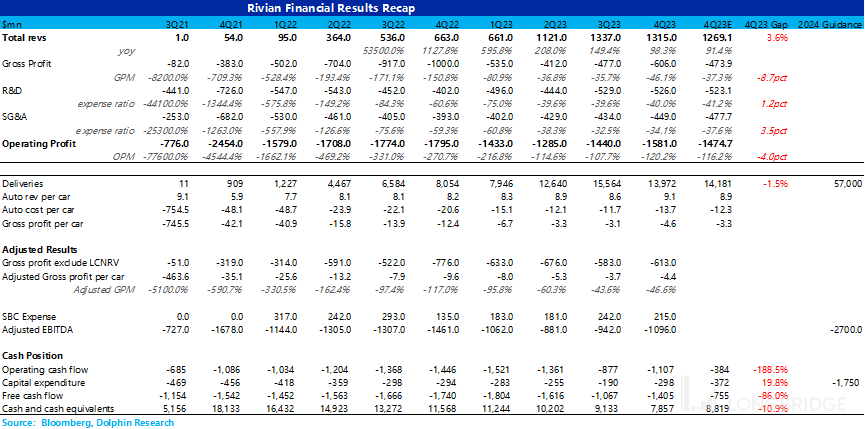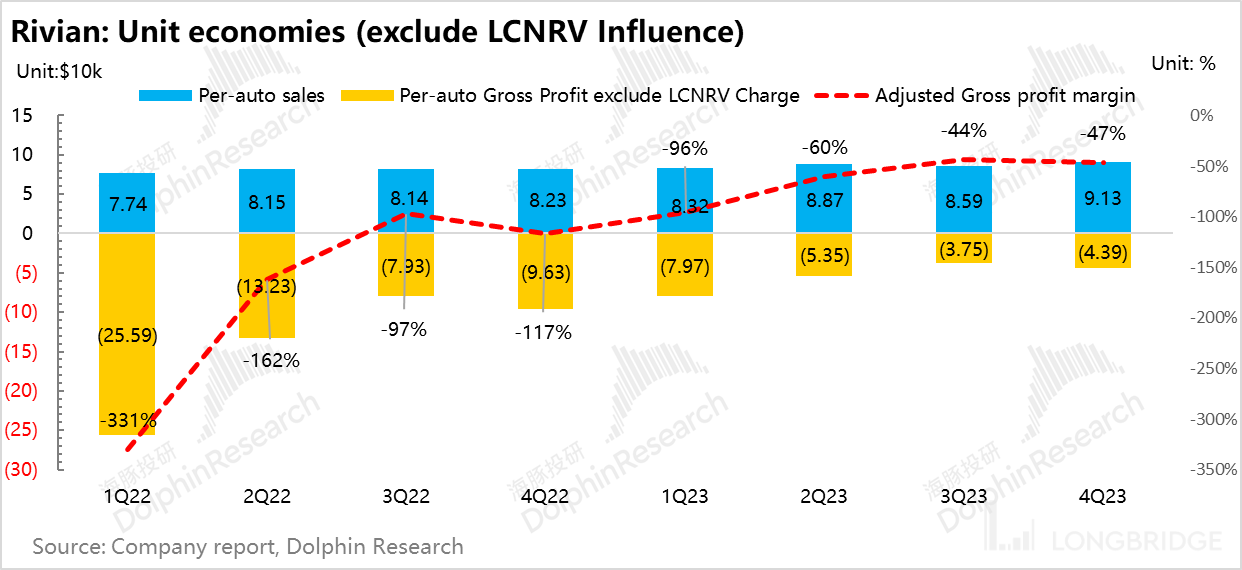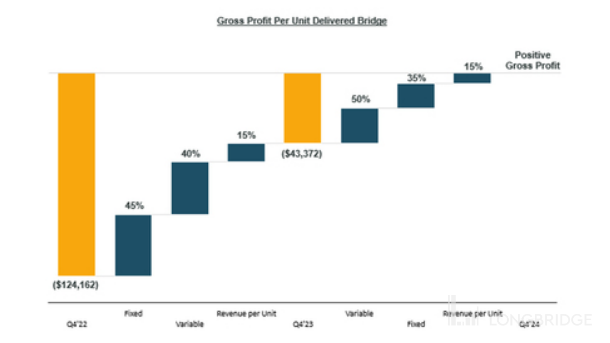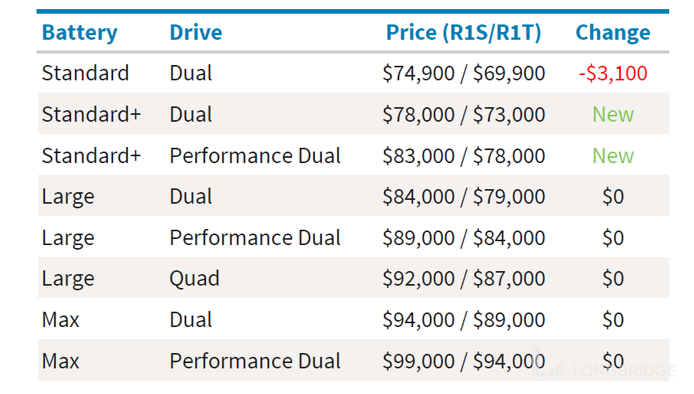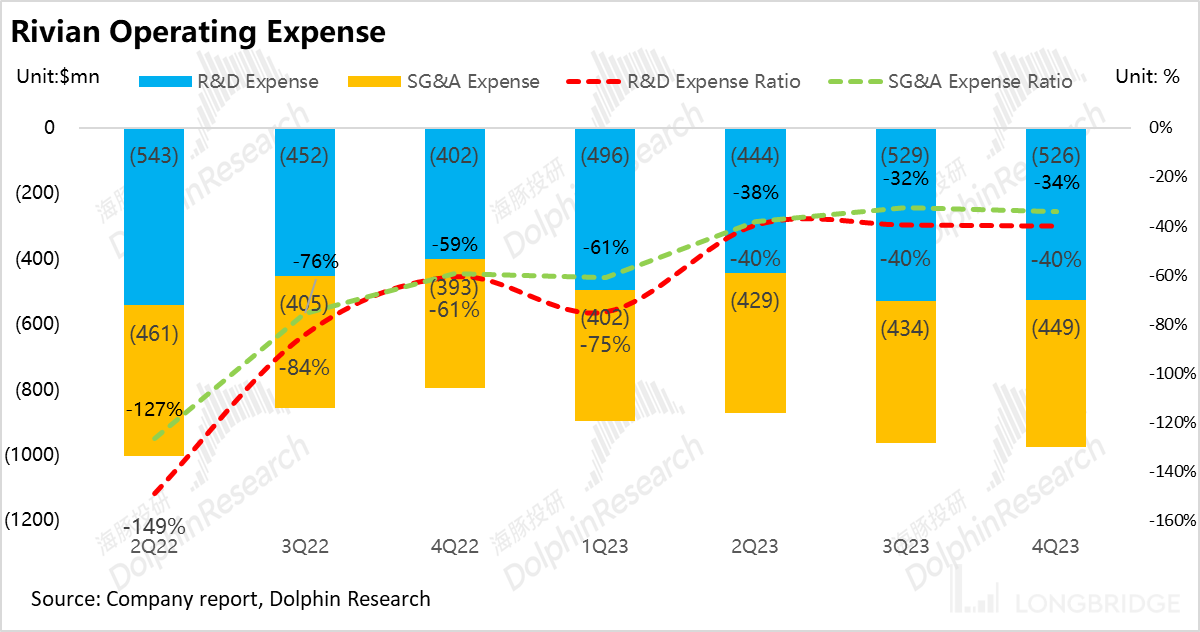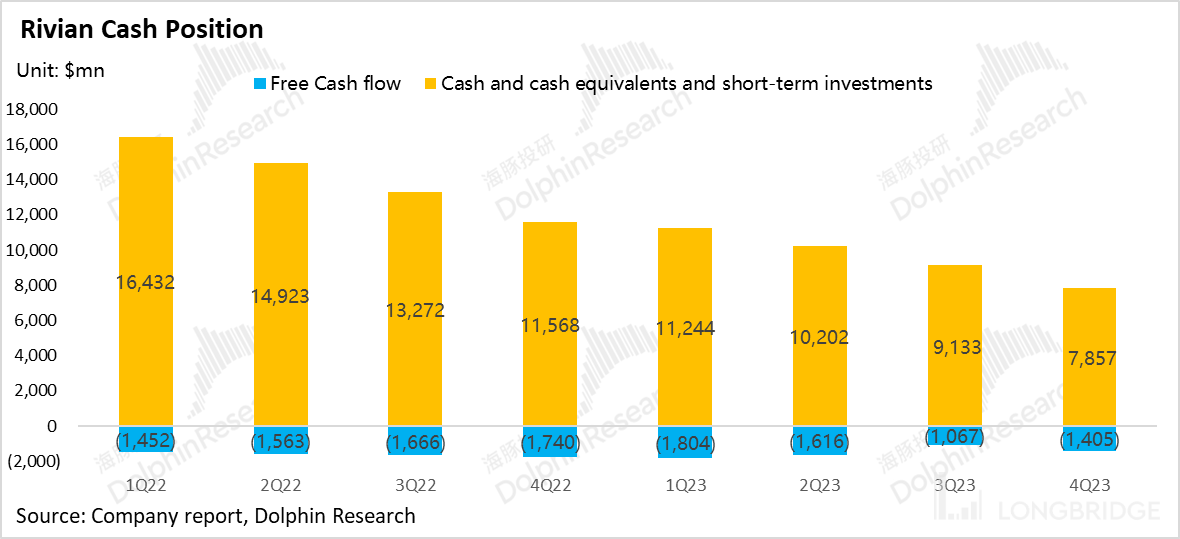With Both Gross Margin and Sales Under Pressure, Can "Tesla Killer" Rivian Survive the Existential Threshold?
Rivian Automotive released its fourth-quarter earnings report after the US stock market on February 21, 2024. Here are the key points:
1) Gross margin below expectations, but temporary impact under control: The gross margin deteriorated this quarter, excluding the impact of inventory valuation and contract losses. The gross margin decreased from -44% in the third quarter to -47% in the fourth quarter. This was mainly due to a seasonal decrease in delivery volume of EDV (commercial trucks) with higher gross margins, as well as temporary effects of factory shutdowns and introducing new technology to the R1 platform.
2) Production guidance for 2024 significantly lower than expected: Rivian Automotive's full-year production guidance for 2024 is only 57,000 units, the same as in 2023, indicating almost no increase in sales volume for 2024. The significant decrease in production guidance is a major issue. Dolphin Research believes this is mainly due to a slowdown in demand, signaling the end of the phase where production drove sales for Rivian Automotive.
3) Rivian Automotive still maintains a positive gross margin guidance for the fourth quarter: However, after calculations, Dolphin Research believes that achieving a positive gross margin in the fourth quarter of 2024 will be challenging, given the continued decline in unit prices and almost unchanged fixed costs per unit. The point of achieving a positive gross margin may be delayed until 2025.
4) "Cash-eating Beast" facing financing challenges: Rivian Automotive's cash flow deteriorated in the fourth quarter due to a decrease in operating cash flow caused by the lower gross margin and increased capital investment this quarter.
Simultaneously, the progress towards achieving a positive gross margin is unlikely to be met as scheduled, accelerating the consumption of free cash flow and further increasing the need for financing. The timing of financing may be earlier than previously anticipated by Dolphin Research.
The delay in achieving a positive gross margin for the R1 will raise concerns among investors on how to achieve profitability with the lower pricing of the R2. Rivian Automotive is facing the biggest challenge of financing difficulties.

Dolphin Research's overall view:
Overall, Rivian Automotive delivered a disappointing performance in the fourth quarter, with gross margin below expectations and 2024 sales volume guidance significantly lower than market expectations.
The lower-than-expected gross margin this quarter was mainly due to seasonal factors affecting the delivery volume of EDV (commercial trucks) with higher gross margins, as well as temporary impacts of factory shutdowns and introducing new technology to the R1 platform. However, the main issue lies in the substantial reduction in sales volume guidance.Combining a series of recent moves by Rivian Automotive, such as reducing the price of the still strong-demand R1S by $3,100, opening leasing for the R1S (previously only available for the weakening demand R1T), and introducing an early low-priced standard range version of the R1T/R1S, will drag down Rivian Automotive's gross margin in 2024. This has led Dolphin Research to question whether the rapid decline in demand, exceeding the company's expectations, has caused sales guidance to be significantly lower than market expectations.
2024 is almost a make-or-break year for Rivian Automotive, with both gross margin and sales facing immense pressure:
a) Sales expectations for the first quarter of 2024 continue to decline (10%-15% lower than this quarter), and in 2024 (second and third quarters), Rivian Automotive will face continuous factory shutdowns to improve unit economics, making it difficult to increase sales. Rivian Automotive only has the fourth quarter left to meet its sales targets.
b) There are no new models;
c) Cash burn rate is high; although Rivian Automotive's guidance predicts a positive gross margin in the fourth quarter, the pressure on unit economics is significant due to the dilution effect caused by lower fixed costs from lower sales expectations and the expected continued decrease in unit prices.
If the progress in unit economics improvement falls short of expectations, and sales do not increase, financing becomes difficult. For Rivian Automotive in 2024, it will be a battle for survival to some extent. Winning means being able to finance and continue investing in the R2 platform (affordable car platform), while losing may lead to a cash flow crisis.
I. Fourth-quarter gross margin falls short of expectations
This quarter, Rivian Automotive stopped reducing losses, with a gross margin MoM decrease of 10.4% to -46.1% in the fourth quarter, significantly lower than the market's expected -37.3%.
However, excluding the impairment impact of LCNRV, Rivian Automotive's actual gross margin this quarter is -47%, a 3% decrease from the previous quarter's -44%, which is relatively manageable.
Breaking down unit economics (excluding the impact of LCNRV), the average unit price increased, but the cost per unit increased even more, leading to a continued decline in gross margin:
a) Average unit price:
The average unit price in the fourth quarter was $94,100, $8,200 higher than the third quarter, showing a significant MoM increase in unit price.
However, due to the contribution of regulatory credits in the fourth quarter, which had almost zero contribution in the third quarter, the average unit price in the fourth quarter, excluding this factor, was $91,300, an increase of $5,400 MoM. The main reason for the increase is the lower sales proportion of the lower-priced EDV this quarter due to seasonal factors, while the higher-priced R1S continues to increase its proportion.b) Unit Cost:
The unit cost in the fourth quarter was $135,200, an increase of $12,000 compared to the previous quarter, mainly due to:
Increase in unit depreciation cost: Due to reduced delivery volume in this quarter due to shutdowns and seasonal factors of EDV, the dilution effect on fixed factory costs decreased. The unit depreciation cost in this quarter increased by $2,600 compared to the third quarter, from $11,000 to $14,000.
Increase in unit variable cost: The unit variable cost in this quarter increased by $9,200 compared to the third quarter, from $112,000 to $121,000, mainly due to a decrease in delivery volume of EDV (commercial vehicles) with higher gross margins due to seasonal factors, as well as temporary impacts from factory shutdowns and introducing new technologies to the R1 platform.
c) Unit Gross Profit:
The average unit price increased by $8,200, while the unit cost increased by $12,000. In the fourth quarter, for every car sold, there was a gross loss of $44,000, an increase compared to the third quarter. The adjusted gross profit margin (excluding the impact of LCNRV) decreased to -47%.

II. 2024 Production Outlook significantly lower than expected, possibly due to demand slowdown
While the decrease in gross profit margin this quarter may be attributed to temporary factors, the significantly lower-than-expected 2024 production outlook is a major concern for the market.
Rivian Automotive's production outlook for 2024 is only 57,000 units, on par with 2023, significantly lower than the market's expectation of 80,000 units.
Previously, in Dolphin Research's in-depth analysis of Rivian Automotive in "Rivian Automotive: 'Injured before the battle,' a Tesla killer turned victim?" and "Rivian Automotive: Cybertruck sentenced to death? Premature disabilities are fatal", it was mentioned that the demand for Rivian Automotive's R1T and EDV has structurally slowed down.The demand for R1S remains strong, with Rivian Automotive allocating production of R1S:R1T at a ratio of 7:3, still in the phase where production drives sales.
However, recent actions by Rivian Automotive have led Dolphin Research to believe that the previously backlogged orders for R1S have been nearly fulfilled. R1S is now facing a weakening demand, deteriorating faster than the company's expectations, resulting in sales guidance significantly below market expectations.
- The price of the still strong-demand R1S has been reduced by $3,100.
- Leasing for R1S has been opened up (previously only available for the weakening-demand R1T).
- R1S has been moved into inventory, with current delivery times only taking 1-2 weeks.
- The introduction of the lower-priced standard range versions of R1T/R1S ahead of schedule (not using LFP batteries as planned, still using NCM batteries).
Looking at the production-sales gap, with production exceeding sales by about 7,000 units in 2023, the gap has widened in the fourth quarter. Part of this is due to in-transit vehicles related to EDV delivery times, but the 7,000 unit inventory gap still remains significant compared to Rivian Automotive's annual sales.
III. Can the gross profit margin turn positive?
Based on the significantly lower production outlook than market expectations, Rivian Automotive still aims to achieve a positive gross profit margin in the fourth quarter of 2024. This quarter, Rivian Automotive has provided specific guidance on achieving a positive gross profit margin.

Combining Dolphin Research's previous tests on Rivian Automotive's gross profit margin turning positive:
- Rivian Automotive has shifted the previous focus on increasing unit prices to improving gross profit through slightly better non-automotive sales revenue (accessories, peripherals, software, etc.), leading to an expected 15% increase in gross profit margin:
Previously, in the assumption of achieving a positive gross profit margin, Rivian Automotive management proposed: 1. Introducing the max pack, 2. Increasing the proportion of high-priced R1S versions. However, with Rivian Automotive currently reducing the price of the standard range version by $3,100 and introducing the lower-priced standard+, this will have a negative impact on Rivian Automotive's unit prices.If we assume that the demand for Rivian Automotive may weaken, the sales of the Max and Large versions may be eroded by the lower-priced Standard version.
Looking at the effects of Tesla's price reductions and promotions over the past year, it did not bring the expected significant increase in demand. If Rivian's SR model fails to alleviate the slowdown in demand, further price reductions may be necessary to achieve sales targets.
Based on these factors, Rivian Automotive has shifted its focus from raising unit prices to increasing the proportion of non-automobile sales revenue from other slightly more profitable sources (accessories, peripherals, software, etc.), which is expected to bring a 15% increase in gross profit margin. However, it is difficult for service revenue to increase significantly, the path to monetizing software remains long, and the new energy transformation of domestic car companies is not expected to bring much revenue from car credits.
Rivian Automotive anticipates a 35% increase in gross profit margin from dilution of fixed costs:
However, looking at the production outlook for 2024, with an estimated production volume of only 57,000 units, which is basically the same as 2023, sales are also expected to remain flat compared to 2023, with no new incremental sales.
Rivian Automotive expects a further decline in sales in the first quarter of 2024 (10%-15% lower than this quarter). In 2024 (second and third quarters), Rivian Automotive will continue to shut down factories to improve per-vehicle economics, but sales are unlikely to increase. Rivian Automotive only has the fourth quarter left to achieve its sales target.
Currently, Rivian Automotive's capacity utilization rate is only about 33%. In 2024, without any increase in sales to dilute fixed depreciation and amortization costs, it is almost impossible for Rivian Automotive to achieve a 35% increase in gross profit margin through dilution of fixed costs.
Rivian Automotive attributes the main factor for turning its gross profit margin positive to the improvement in variable costs (expected to bring a 50% increase in gross profit margin).
Significant cost reductions still need to rely on reducing variable costs. The previous EDV model achieved a 35% reduction in variable costs by replacing raw materials before shutting down the factory.

At the forefront of electrification, Rivian Automotive has developed a new in-house Enduro motor that reduces costs. The most significant advancement is the second-generation self-developed electronic architecture for control, reducing the number of ECUs by 60% and shortening wiring harnesses by 25%. This technology will be applied to the R1 platform.
c) Renegotiation of core supplier procurement contracts: Previous contracts were signed when the R1 platform was just launched. At that time, uncertainties in R1 production volume led to high procurement costs. Now, potential sales volume from the R2 platform can bring about procurement premiums.
d) Natural cost reduction of battery materials, with the price of lithium carbonate likely to drop below 100,000 RMB/ton by 2024.
It can be seen that Rivian Automotive expects a continuous decrease in unit prices. Due to production constraints, fixed costs are unlikely to dilute, and most factors rely on reducing variable costs.
Based on Dolphin Research's previous assumption of a positive gross margin, even with a successful introduction of cost-reducing technological architecture, the per-vehicle cost can only decrease by 26,000. Excluding LCNRV's gross loss of -44,000 this quarter, with a continued decline in vehicle prices and almost unchanged fixed costs per vehicle, Dolphin Research believes that achieving a positive gross margin in the fourth quarter of 2024 will be challenging, possibly postponed to 2025.
Rivian Automotive's early release of the standard+ version, which did not follow the original plan to reduce costs using LFP batteries, is priced only $9,100 lower than the large version. However, the battery pack is only reduced by 14kWh, saving about $3,000 in BOM costs, further burdening the gross margin.

4. Reasonable Operating Expense Control
1) Research and Development Expenses: In this quarter, Rivian Automotive's R&D expenses reached $530 million, slightly higher than the market's expected $520 million.
In terms of R&D investment, Rivian Automotive needs electrification vertical integration and next-generation technology platforms to reduce costs, alleviate supply chain issues, and increase production. This is currently the focus of Rivian Automotive's layout. Dolphin Research predicts that R&D expenses will remain rigid in 2024, making cost reduction challenging.
However, in terms of intelligent driving layout, although Rivian Automotive has developed the Driver+ system, its level of intelligence only reaches L2. There is still a significant gap compared to Tesla's self-driving technology based on algorithm chips and self-built supercomputing centers, forming a closed loop.
- Sales and Administrative Expenses: This quarter, sales and administrative expenses were $4.5 billion, lower than the market's expected $4.8 billion, showing reasonable control over expenses.
Similar to Tesla's sales model, Rivian Automotive adopts a direct + online sales model. In the fourth quarter, they only added 13 service centers (currently 56), with plans to open 26 new service centers and 17 Rivian Automotive spaces in 2024.
Rivian Automotive also announced a projected 10% workforce reduction to reduce costs and increase efficiency, expecting a decrease in administrative expenses in 2024.
This quarter, Rivian Automotive incurred an operating loss of $1.58 billion, with an operating loss rate of -120%, a 13% decrease from the previous quarter. This was mainly due to a decrease in gross profit margin and a slight increase in operating expense ratio.

- V. Rivian Automotive's Financing Challenges
The financial market has become extremely stringent on refinancing for new energy vehicle companies. Refinancing at a time when both sales volume and gross profit margin are under pressure will inevitably incur high costs, with the market not showing much confidence.
Rivian Automotive's free cash flow deteriorated in the fourth quarter, decreasing from -$1.1 billion in the third quarter to -$1.4 billion in the fourth quarter. This was mainly due to a decrease in operating cash flow caused by a lower gross profit margin and increased capital investment this quarter.
Considering the possible worsening of cash flow due to production halts in the second and third quarters of next year, Dolphin Research estimates that by the end of 2024, Rivian Automotive may face a cash shortfall, possibly as early as the beginning of 2025. Additionally, with the launch of the R2 platform in 2026, Rivian Automotive will need around $7 billion in financing to support the construction of the R2 platform and future growth.
However, due to the demand slowdown Rivian Automotive is currently facing, Dolphin Research predicts that achieving a positive gross profit margin is almost unlikely on schedule. This will accelerate the consumption of free cash flow, further increasing the need for financing, possibly earlier than previously estimated.
Furthermore, the delay in achieving a positive gross profit margin for R1 will raise concerns among investors about how to achieve profitability under the low pricing of R2.As Dolphin Research mentioned before, 2024 is a make-or-break year for Rivian Automotive. Currently, both gross profit margin and sales volume are under tremendous pressure, with the unit economics facing significant challenges and cash burn rate expected to accelerate.
For Rivian Automotive in 2024, it's a battle for survival to some extent. Winning means being able to raise funds to continue investing in the R2 platform (affordable car platform), while losing could lead to a cash flow crisis.

Longbridge Dolphin Research's in-depth research and analysis on Rivian Automotive include:
Earnings Reports
Earnings report analysis on November 8, 2023: "Rivian Automotive surpasses expectations again, is the 'Tesla Killer' able to cross the life-or-death line?"
Conference call on November 8, 2023: "Rivian Automotive: Continuing efforts to achieve positive gross margin in 2024 (3Q conference call summary)"
In-depth Analysis
In-depth analysis on December 6, 2023: "Rivian Automotive: Is Cybertruck doomed? Premature disabilities are the fatal blow"
In-depth analysis on December 4, 2023: "Rivian Automotive (Part 1): 'Wounded before the battle,' is the 'Tesla Killer' becoming the killed?"
July 7, 2022, in-depth analysis "Amateur or Superhero? The Dilemma of Rivian Automotive" on Longbridge.
March 8, 2022, in-depth analysis "Little Superhero's Pickup: The Ambition of Rivian Automotive" on Longbridge.
Risk Disclosure and Statement of this Article: Dolphin Research Disclaimer and General Disclosure




